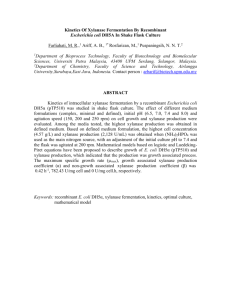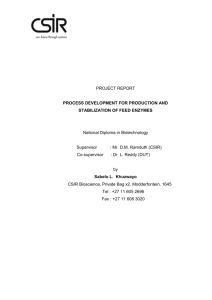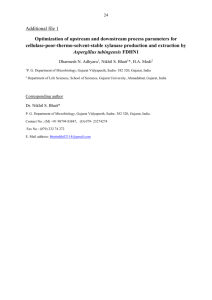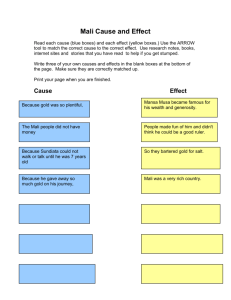Advance Journal of Food Science and Technology 9(9): 701-705, 2015
advertisement
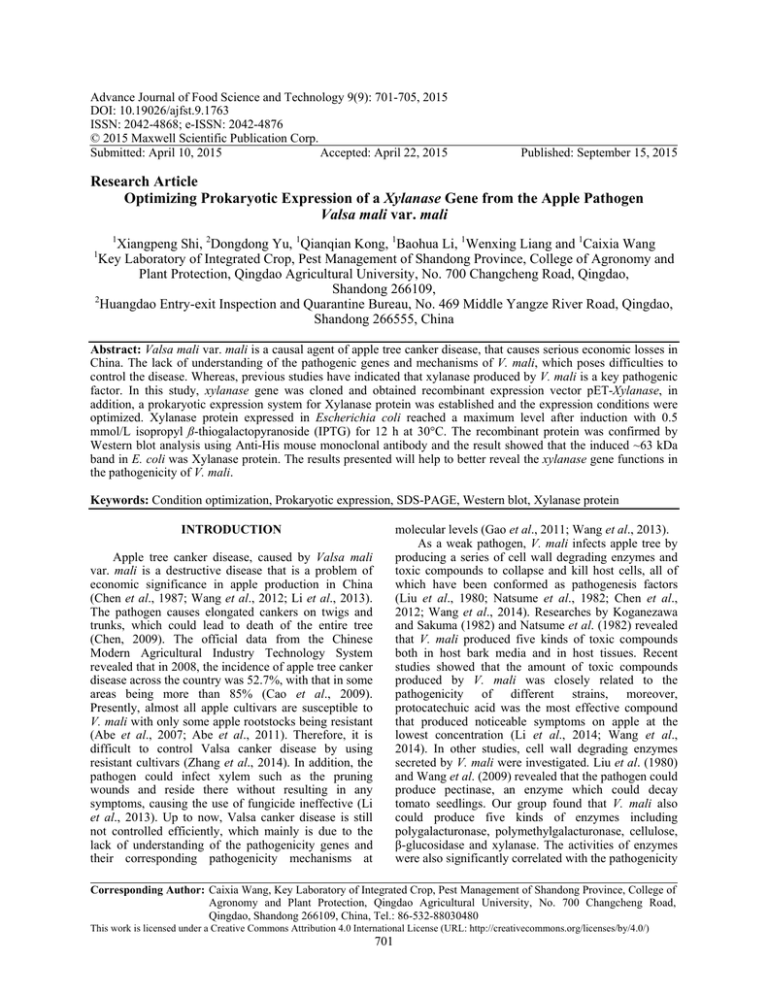
Advance Journal of Food Science and Technology 9(9): 701-705, 2015 DOI: 10.19026/ajfst.9.1763 ISSN: 2042-4868; e-ISSN: 2042-4876 © 2015 Maxwell Scientific Publication Corp. Submitted: April 10, 2015 Accepted: April 22, 2015 Published: September 15, 2015 Research Article Optimizing Prokaryotic Expression of a Xylanase Gene from the Apple Pathogen Valsa mali var. mali 1 Xiangpeng Shi, 2Dongdong Yu, 1Qianqian Kong, 1Baohua Li, 1Wenxing Liang and 1Caixia Wang Key Laboratory of Integrated Crop, Pest Management of Shandong Province, College of Agronomy and Plant Protection, Qingdao Agricultural University, No. 700 Changcheng Road, Qingdao, Shandong 266109, 2 Huangdao Entry-exit Inspection and Quarantine Bureau, No. 469 Middle Yangze River Road, Qingdao, Shandong 266555, China 1 Abstract: Valsa mali var. mali is a causal agent of apple tree canker disease, that causes serious economic losses in China. The lack of understanding of the pathogenic genes and mechanisms of V. mali, which poses difficulties to control the disease. Whereas, previous studies have indicated that xylanase produced by V. mali is a key pathogenic factor. In this study, xylanase gene was cloned and obtained recombinant expression vector pET-Xylanase, in addition, a prokaryotic expression system for Xylanase protein was established and the expression conditions were optimized. Xylanase protein expressed in Escherichia coli reached a maximum level after induction with 0.5 mmol/L isopropyl ß-thiogalactopyranoside (IPTG) for 12 h at 30°C. The recombinant protein was confirmed by Western blot analysis using Anti-His mouse monoclonal antibody and the result showed that the induced ~63 kDa band in E. coli was Xylanase protein. The results presented will help to better reveal the xylanase gene functions in the pathogenicity of V. mali. Keywords: Condition optimization, Prokaryotic expression, SDS-PAGE, Western blot, Xylanase protein molecular levels (Gao et al., 2011; Wang et al., 2013). As a weak pathogen, V. mali infects apple tree by producing a series of cell wall degrading enzymes and toxic compounds to collapse and kill host cells, all of which have been conformed as pathogenesis factors (Liu et al., 1980; Natsume et al., 1982; Chen et al., 2012; Wang et al., 2014). Researches by Koganezawa and Sakuma (1982) and Natsume et al. (1982) revealed that V. mali produced five kinds of toxic compounds both in host bark media and in host tissues. Recent studies showed that the amount of toxic compounds produced by V. mali was closely related to the pathogenicity of different strains, moreover, protocatechuic acid was the most effective compound that produced noticeable symptoms on apple at the lowest concentration (Li et al., 2014; Wang et al., 2014). In other studies, cell wall degrading enzymes secreted by V. mali were investigated. Liu et al. (1980) and Wang et al. (2009) revealed that the pathogen could produce pectinase, an enzyme which could decay tomato seedlings. Our group found that V. mali also could produce five kinds of enzymes including polygalacturonase, polymethylgalacturonase, cellulose, β-glucosidase and xylanase. The activities of enzymes were also significantly correlated with the pathogenicity INTRODUCTION Apple tree canker disease, caused by Valsa mali var. mali is a destructive disease that is a problem of economic significance in apple production in China (Chen et al., 1987; Wang et al., 2012; Li et al., 2013). The pathogen causes elongated cankers on twigs and trunks, which could lead to death of the entire tree (Chen, 2009). The official data from the Chinese Modern Agricultural Industry Technology System revealed that in 2008, the incidence of apple tree canker disease across the country was 52.7%, with that in some areas being more than 85% (Cao et al., 2009). Presently, almost all apple cultivars are susceptible to V. mali with only some apple rootstocks being resistant (Abe et al., 2007; Abe et al., 2011). Therefore, it is difficult to control Valsa canker disease by using resistant cultivars (Zhang et al., 2014). In addition, the pathogen could infect xylem such as the pruning wounds and reside there without resulting in any symptoms, causing the use of fungicide ineffective (Li et al., 2013). Up to now, Valsa canker disease is still not controlled efficiently, which mainly is due to the lack of understanding of the pathogenicity genes and their corresponding pathogenicity mechanisms at Corresponding Author: Caixia Wang, Key Laboratory of Integrated Crop, Pest Management of Shandong Province, College of Agronomy and Plant Protection, Qingdao Agricultural University, No. 700 Changcheng Road, Qingdao, Shandong 266109, China, Tel.: 86-532-88030480 This work is licensed under a Creative Commons Attribution 4.0 International License (URL: http://creativecommons.org/licenses/by/4.0/) 701 Adv. J. Food Sci. Technol., 9(9): 701-705, 2015 of strains, meanwhile, xylanase activity was the highest among all the enzymes in the infection of pathogen and it showed the most powerful macerating ability to apple tissues (Chen et al., 2012; Li et al., 2014). Despite all the results indicated that xylanase was a key pathogenic factor of V. mali, its gene functions have yet to be determined. To clearly understand the functions of xylanase gene of V. mali, the gene was successfully cloned using RACE technology and recombinant expression vector pET-Xylanase was constructed in our previous work. In this study, recombinant plasmid pET-Xylanase was transformed into Escherichia coli and Xylanse protein expression procedure was optimized to increase heterologous expression efficiency. Furthermore, recombinant Xylanase protein was analyzed by dodecyl sulphate-polyacrylamide gel electrophoresis (SDSPAGE) and Western blot. MATERIALS AND METHODS Fungal strain, plasmids and culture medium: Valsa mali var. mali isolate LXS080601 isolated from infected ‘Fuji’ apple branch, was identified and maintained as previously described (Chen et al., 2012; Zhao et al., 2012). Xylanase gene cloning, plasmid amplification and preparation were performed followed routine protocols (Wang et al., 2007) in our previous work (not published). Escherichia coli strain DH 5α, Rosetta (DE3) and vector pMD 18-T, pET 32a were purchased from Takala (Dalian, China) and Novagen (Darmstadt, Germany) Ltd. Luria-Bertani (LB) broth was prepared with 5 g/L yeast extract, 10 g/L tryptone and 10 g/L NaCl. Autoclave was performed at 121°C for 20 min. E. coli transformation and gene expression: E. coli cells were grown in LB medium and prepared for transformation following the manufacturer’s instruction. The cells were transformed with the recombinant vector using heat shock method. The recombinant E. coli Rosetta colony was picked with a sterilized toothpick and transferred into 5 mL LB culture liquid supplemented with 50 mg/L ampicillin. The culture was put in a shaker at 37°C overnight with a constant speed of 180 r/min. Then, 0.1 mL of this culture was inoculated into 10 mL LB medium supplemented 100 mg/L ampicillin and grown at 37°C with vigorous shaking until OD600 reached 0.5. To induce target protein expression, different culture conditions were optimized followed the pET System Manual (Novagen, Darmstadt, Germany). The cells were harvested by centrifugation at 10 000×g for 10 min. Every sample was prepared from 1.5 mL of culture liquid with various parameters and protein expression levels were assessed using dodecyl sulphatepolyacrylamide gel electrophoresis (SDS-PAGE) (Heegaard et al., 2002; Wang et al., 2007). Optimization of protein expression in E. coli: Optimal conditions for Xylanase protein expression were determined with different isopropyl ßthiogalactopyranoside (IPTG, Invitrogen, USA) concentrations, induction time and temperature. When the OD600 reached 0.5, IPTG was added with the different final concentrations of 0, 0.05, 0.1, 0.2, 0.5, 1.0 and 2.0 mmol/L. 2 mL liquid culture was collected at 0, 2, 4, 6, 8, 10 and 12 h after IPTG addition, respectively. Then, the protein expression was induced at different temperature (20, 30 and 37°C), with a shaking speed of 180 r/min for 8 h. Cells were centrifuged and resuspended in lysis buffer (125 mmol/L Tris-HCl, containing 40 g/L SDS, 20% glycerin, 10 mmol/L ß-mercaptoethanol). The induced proteins were separated in 12% SDS-PAGE and visualized by staining with Coomassie Blue G250. Recombinant protein detection and western blotting analysis: The expressed protein with the optimization condition was verified by Western blotting analysis (Wang et al., 2007). Recombinant proteins were resolved by SDS-PAGE on 12% polyacrylamide gels and transfered onto polyvinylidene difluoride (PVDF, Roche, Switzerland) membranes, which were pretreated by methanol. The membranes were incubated with blocking solution (0.5% Bovine serum albumin in 10 mmol/L Phosphate Buffered Saline (PBS)) for 2 h at room temperature with constant shaking and were subsequently probed with diluted Anti-His mouse monoclonal antibody (1:5 000) for 2 h. The membrane was washed and then incubated for 2 h with horse antimouse IgG secondary antibody conjugated with alkaline phosphatase (Promege, Madison, USA). Lastly, the membrane was washed and detected using nitroblue tetrazolium chloride (NBT) and 5-bromo-4chloro-3-indolyphosphate (BCIP) (Promega, USA). RESULTS Cloning of the Xylanase gene: Xylanase gene was amplified by PCR from the recombinant plasmid pMDXylanase. The expected 1320 bp product was cloned into the pET-32a vector in order to obtain prokaryotic expression of N-terminally His-tagged Xylanase, which could be detected and purified using His antibody and nickel resin column, respectively. The recombinant vector pET-Xylanase was transformed into E. coli Rosetta. The positive colonies were picked and verified by PCR with the primers of Xlyanase R/Xlyanase F Fig. 1: Identification of recombinants in E. coli by polymerase chain reaction assay with Xylanase primers. Lane M: DNA molecular weight marker with bases indicated on the left. Lane 1: negative control with vector pET-32a; Lanes 2 to 5: putative recombinants 702 Adv. J. Food Sci. Technol., 9(9): 701-705, 2015 Fig. 2: SDS-PAGE analysis on the optimized expression time of Xylanase protein in E. coli Rosetta with Coomassie blue staining. Lane M: protein molecular weight marker. Lane 1: cell pellet fractions of vector pET 32a as negative control after induction with 1.0 mmol/L IPTG for 12 h. Lane 2 to 7: cell pellet fractions of pET-Xylanase after induction with 1.0 mmol/L IPTG for 2, 4, 6, 8, 10 and 12 h, respectively. The recombinant protein band was observed at molecular weight of ~63 kDa (arrow) compared with the negative control. The band intensity increased from 2 h after induction and reached a maximum level at 12 h with IPTG induction, the optimum time for Xylanase protein expression Fig. 3: SDS-PAGE analysis on the optimized IPGT concentrations for Xylanase protein expression in E. coli Rosetta with Coomassie blue staining. Lane M: protein molecular weight marker. Lane 1: cell pellet fractions of vector pET 32a after induction with 1.0 mmol/L IPTG for 6 h. Lane 2: cell pellet fractions of pET-Xylanase before induction (0 h). Lane 3 to 8: cell pellet fractions of pET-Xylanase after induction with 0.05, 0.1, 0.2, 0.5 1.0 and 2.0 mmol/L IPTG for 6 h, respectively. The recombinant protein band intensity (arrow) increased from 0.05 mmol/L IPTG induction and reached a maximum level with 0.5 mmol/L IPTG, the optimum IPTG concentration for Xylanase protein expression (Fig. 1). Sequence analysis confirmed that the insert into the pET-Xylanase plasmid showed 100% identify with the target Xylanase gene. Optimization of Xylanase gene expression in E. coli: Induction expression of Xylanase protein was optimized by altering different parameters and production levels were analyzed by SDS-PAGE as shown in Fig. 2. Upon induction of Xylanase expression from E. coli containing pET-Xylanase, a ~63 kDa band of increasing intensity was observed, which was absent in the negative control (empty vector Fig. 4: SDS-PAGE analysis on the optimized induction temperature for Xylanase protein expression in E. coli Rosetta with Coomassie blue staining. Lane M: protein molecular weight marker. Lane 1, 3 and 5: cell pellet fractions of pET-Xylanase after induction at 37, 30 and 20°C, respectively, with 0.5 mmol/L IPTG for 12 h. Lane 2, 4 and 6: soluble fractions of pETXylanase after induction at 37, 30 and 20°C, respectively, with 0.5 mmol/L IPTG for 12 h. The recombinant protein band (arrow) only was observed in the pellet, but not in the soluble fractions. The production of Xylanase protein reached a maximum level at 30°C, the optimum induction temperature for protein expression Fig. 5: Western blot analysis on the recombinant Xylanase protein probed with Anti-His mouse monoclonal antibody. Lane M: pre-stained protein molecular weight marker. Lane 1 and 4: cell pellet fractions of vector pET 32a as negative control. Lane 2 and 5, Lane 3 and 6: cell pellet fractions of pET-Xylanase after induction with 0.5 mmol/L IPTG for 8 h at 30°C. The ~63 kDa recombinant Xylanase protein was confirmed (arrow) pET 32a). Production of the protein was increased with induction time after induction with 1.0 mmol/L IPTG and reached a maximum level at 12 h with IPTG induction, the optimum time for Xylanase protein expression (Fig. 2). For different IPGT concentrations induction, the recombinant protein band intensity increased from 0.05 mmol/L IPTG and reached a maximum level with 0.5 mmol/L IPTG, the optimum IPTG concentration for Xylanase protein expression (Fig. 3). The recombinant protein expression in E. coli Rosetta induction at 30°C was higher than the value obtained induced by the other temperatures. However, the Xylanase protein only was observed in the pellet fractions, no target protein band was appeared in the soluble fractions (Fig. 4). 703 Adv. J. Food Sci. Technol., 9(9): 701-705, 2015 Confirmation of recombinant protein by western blot analysis: Following optimization of Xylanase protein expression in E. coli, recombinant protein was detected by Western blot analysis using Anti-His mouse monoclonal antibody (Fig. 5). The result further indicated that the induced ~63 kDa band in E. coli was Xylanase recombinant protein. DISCUSSION Xylanase gene from V. mali var. mali was successfully cloned into a prokaryotic expression vector and transformed into E. coli. Full-length recombinant Xylanase protein was subsequently expressed and optimized, yielding a ~63 kDa protein. However, the predicted molecular weight of Xylanase protein is ~45 kDa. The discrepancy between the calculated and expressed molecular weights could be explained by the presence of His-tag (~18 kDa) in recombinant Xylanase protein (Pei et al., 2014). The recombinant Xylanase protein was identified by Western blot analysis with Anti-His mouse monoclonal antibody. Although heterologous protein expression in E. coli is widely applied for gene function analysis, its efficiency varies among different gene and even the expression vector or E. coli strain used could also impact the efficiency (Hannig and Makrides, 1998; Sørensen and Mortensen, 2005; Munjal et al., 2015). In order to determine the optimal expression condition of Xylanase protein, expression vector pET 32a and E. coli Rosetta were selected (Bai et al., 2013). In our study, Xylanase protein also could be expressed in E. coli BL21, however, the protein concentration was extremely low (data not shown). In addition, the induced time, temperature and IPTG concentration were also optimized. It was found that using 0.5 mmol/L IPTG and 12 h induced time at 30°C could result in the highest expression efficiency. IPTG is necessary for heterologous protein expression in E. coli, which is also verified by our study in which adding an optimum concentration of IPTG (0.5 mmol/L) enhanced protein expression amount. However, too high concentration of IPTG (1 and 2 mmol/L) inhibited Xylanase protein expression; probably due to high IPTG concentration inhibited the growth of E. coli cells (Pei et al., 2014). Expression vector, pET 32a, contains a His-tag which not only can improve the translation efficiency, but also can be used as a marker to purify the recombinant protein expressed in E. coli (Bai et al., 2013). The heterologous expression and optimization of conditions of Xylanase gene will provide a basis for further revealing the functions of xylanase produced by V. mali. CONCLUSION Here we report, for the first time, the development and optimization of Xylanase protein expression in E. coli, a key pathogenic factor of V. mali. The optimized conditions enabled us to obtain a large number of Xylanase protein and it's easy to purify the recombinant protein using His-tag. Therefore, it will be useful for further understanding of the pathogenesis mechanisms of xylanase gene and for better exploration of new strategies to control Valsa canker disease. ACKNOWLEDGMENT This research was supported by grants from the National Natural Science Foundation of China (grant No. 31272001), the Chinese Modern Agricultural Industry Technology System (grant No. CARS-28), the Special Fund for Agro-scientific Research in the Public Interest (grant No. 201203034-02) and the Tai-Shan Scholar Construction Foundation of Shandong province. REFERENCES Abe, K., N. Kotoda, H. Kato and J. Soejima, 2007. Resistance sources to Valsa canker (Valsa ceratosperma) in a germplasm collection of diverse Malus species. Plant Breeding, 126: 449-453. Abe, K., N. Kotoda, H. Kato and J. Soejima, 2011. Genetic studies on resistance to Valsa canker in apple: Genetic variance and breeding values estimated from intra-and inter-specific hybrid progeny populations. Tree Genet. Genomes, 7: 363-372. Bai, S., C. Dong, B. Li and H. Dai, 2013. A PR-4 gene identified from Malus domesticais involved in the defense responses against Botryosphaeria dothidea. Plant Physiol. Biochem., 62: 23-32. Cao, K.Q., L.Y. Guo, B.H. Li, G.Y. Sun and H.J. Chen, 2009. Investigations on the occurrence and control of apple canker in China. Plant Protect., 35: 114-117. Chen, C., M.N. Li, X.Q. Shi, J.G. Guo, Z.F. Xing, X.W. Zhang and Y.X. Chen, 1987. Studies on the infection period of Valsa mali Miyabe et Yamada, the causal agent of apple tree canker. Acta Phytopathol. Sin., 17: 65-68. Chen, C., 2009. Research on the Occurrence Regularity and Control of Apple Tree Canker. China Agricultural Scientech Press, Beijing, China, pp: 9-17. Chen, X.L., C.W. Niu, B.H. Li, G.F. Li and C.X. Wang, 2012. The kinds and activities of cell walldegrading enzymes produced by Valsa ceratosperma. Acta Agr. Boreali-Sin., 27: 207-212. Gao, J., Y.B. Li, X.W. Ke, Z.S. Kang and L.L. Huang, 2011. Development of genetic transformation system of Valsa mali of apple mediated by PEG. Acta Microbiol. Sin., 51: 1194-1199. Hannig, G. and S.C. Makrides, 1998. Strategies for optimizing heterologous protein expression in Escherichia coli. Trends Biotechnol., 16: 54-60. 704 Adv. J. Food Sci. Technol., 9(9): 701-705, 2015 Heegaard, E.D., C.J. Rasksen and J. Christensen, 2002. Detection of parvovirus B19 NS1-specific antibodies by ELISA and western blotting employing recombinant NS1 protein as antigen. J. Med. Virol., 67: 375-383. Koganezawa, H. and T. Sakuma, 1982. Possible role of breakdown products of phloridzin in symptom development by Valsa ceratosperma. Ann. Phytopathol. Soc. Jpn., 48: 521-528. Li, B.H., C.X. Wang and X.L. Dong, 2013. Research progress in apple diseases and problems in the disease management in China. Plant Protect., 39: 46-54. Li, C., B.H. Li, G.F. Li and C.X. Wang, 2014. Pathogenic factors produced by Valsa mali var. mali and their relationship with pathogenicity of different strains. North. Hortic., 13: 118-122. Liu, F.C., M.N. Li and Y.Q. Wang, 1980. Preliminary study on the virulence factor (pectinase) of valsa ceratosperma. China Fruits, 4: 45-48. Munjal, N., K. Jawed, S. Wajid and S.S. Yazdani, 2015. A constitutive expression system for cellulase secretion in Escherichia coli and its use in bioethanol production. PloS One, 10: e0119917. Natsume, H., H. Seto, S. Haruo and N. Ōtake, 1982. Studies on apple canker disease: the necrotic toxins produced by Valsa ceratosperma. Agr. Biol. Chem. Tokyo, 46: 2101-2106. Pei, D.L., H.Y. Zhang, M. Li, Z.L. Duan and C.W. Li, 2014. Optimization of prokaryotic expression of ShSTU1 gene in tomato resistant to powdery mildew. J. Henan Univ., Nat. Sci., 44(2): 202-207. Sørensen, H.P. and K.K. Mortensen, 2005. Advanced genetic strategies for recombinant protein expression in Escherichia coli. J. Biotechnol., 115: 113-128. Wang, C., C. Li, B. Li, G. Li, X. Dong, G. Wang and Q. Zhang, 2014. Toxins produced by Valsa mali var. mali and their relationship with pathogenicity. Toxins, 6(3): 1139-1154. Wang, C.X., N. Hong, G.P. Wang, J.K. Zhang and L. Hui, 2007. Molecular analysis of a Chinese citrus tristeza virus isolate showing anomalous serological reactions. J. Plant Pathol., 89(3): 377-383. Wang, C.X., X.L. Dong, Z.F. Zhang, G.F. Li and B.H. Li, 2012. Outbreak and the reasons of apple valsa canker in Yantai apple production area in 2011. Plant Protect., 38: 136-138. Wang, C.X., X.N. Guan, H.H. Wang, G.F. Li, X.L. Dong, G.P. Wang and B.H. Li, 2013. Agrobacterium tumefaciensmediated transformation of Valsa mali: An efficient tool for random insertion mutagenesis. Sci. World J., 2013: 11. Wang, J., Q. Ma, X. Zhuang and L.P. Yang, 2009. Determination of pectinase in fungi secretion of apple tree canker. Inner Mongolia Agric. Sci. Tech., 4: 39-40. Zhang, Q., C. Wang, D. Yong, G. Li, X. Dong and B. Li, 2014. Induction of resistance mediated by an attenuated strain of Valsa mali var. mali using pathogen-apple callus interaction system. Sci. World J., 2014: 201382. Zhao, H., C.X. Wang, X.R. Chen, H.Y. Wang and B.H. Li, 2012. Methods of promoting porulation of Valsa ceratosperma. Chin. Agric. Sci. Bull., 28: 151-154. 705
